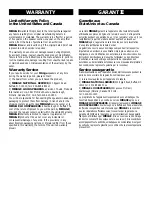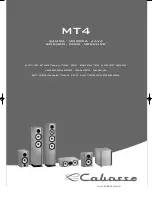
CONTROLS ON POWERED MODELS
Low Frequency (LF) EQ Control
Low Frequency and Level Controls
The subwoofer, or as we prefer to refer to it as the active low
frequency section, uses new circuitry to protect the overall tonal
balance as well as permit tailoring to a specific frequency range.
Previously, a Level control for the amount of bass output and a Low
Frequency EQ control, variable -3db to +3db, allowed adjustments to
the extreme low frequency characteristics. This did allow tailoring for
room characteristics and personal tastes but there were trade-offs
inherent to this design. It meant that all low frequencies were equally
boosted, even if you just desired a specific range to be enhanced. For
instance, even if you wanted to boost just the 50Hz range, all
frequencies up to midrange crossover point were equally amplified,
potentially resulting in unwanted bass in other frequencies ranges. The
new circuitry system addresses this and has perfected a method of
pinpointing the desired frequency range to be modified. The selected
point on the Low Frequency represents the desired range of
frequencies to be modified and is used as the gradual start of a
parabolic curve, varying in slope based on the selected point on the
Level Control, variable from -6db to 18db. The parabolic shape, or "roll
in slope" means that a very specific range of frequencies represented by
the apex of the curve will be modified as opposed to boosting all
frequencies equally under the desired crossover point.You can boost a
wide or narrow region of frequencies without disturbing the vital tonal
balance. The speaker is in a flat, or zero tailoring to the low frequency
section, as long as the level control is set at the 0db position and the
frequency is set at 90Hz.
Auto-On/Auto-Off
The subwoofer section of the OM-5 is equipped with a circuit that
automatically turns the sub on as soon as it senses a low frequency
signal. At a predetermined time after the signal ends, this circuit
automatically switches the subwoofer to a stand-by mode.
Clipping Protection
Mirage's proprietary Clipping Protection Circuit (CPC) continuously
senses the input signal level and automatically adjusts to prevent
unwanted clipping of the waveform to maintain undistorted bass
reproduction.
LED
A red LED located at the front of the speaker will always be visible
when the speaker is plugged into a receptacle and ready to be played.
This LED will turn green when in use.
SURROUND SOUND APPLICATIONS
Although the OM series was designed for the discriminating audiophile,
it is also ideally suited for Home Theater applications. The Omnipolar
soundstage will put the listener right in the middle of the action if you
add the following components. (See Figure 4)
Center channel
An accurate sound stage is the ultimate goal of every home theater
enthusiast. This has been attempted by employing main channel
speakers capable of creating a wide and constant sound stage, but
there is one inherent flaw to this rationale. Surround sound processing
will generally direct 60-70% of the film's soundtrack to the center
channel speaker. No matter how well the main channel speakers might
perform, the forward radiating center has always been the weak link,
producing a flatter, directional sound stage. Mirage engineers don't
tolerate compromise, they invent solutions.
Mirage has developed a home theater speaker with a 360 degree
radiation pattern that delivers precise dialog placement while at the
same time imparting the spaciousness and presence impossible to
achieve in conventional center channel designs. It's the world's first and
only Omnipolar center channel speaker, the OM-C2, and it will
revolutionize the home theater listening experience.
The OM-C2's Omnipolar technology is uniform in dispersion, providing
a perfectly spherical, full spectrum sound radiation pattern that greatly
expands the prime listening area. It is this 360-degree radiation pattern
that allows the listener to be positioned up to 90 degrees of the center
channel and still enjoy pinpoint imaging.
Rear Channel
The Mirage OM-R2 is a small surround speaker designed to be
wall mounted and blend seamlessly to any OM speaker. The dual,
1"PTH tweeter and 6.5" polypropylene cone guarantee perfect
timbre matching.
DISTORTION
When an amplifier is driven beyond its capabilities it produces distorted
output power several times greater than its rated power. All amplifiers
produce very high levels of distortion when they are overdriven and
this distortion can damage any speaker. Overdriven amplifier distortion
is called clipping.
Clipping can easily be identified by fuzzy, distorted sounds. If this is
heard, lower the volume of the system immediately to avoid damage to
your system. If louder volumes are desired, the only solution is to
obtain an amplifier capable of delivering more clean, undistorted power.
CABINET CARE
Great care and craftsmanship have gone into the construction and finish
of the OM series cabinet. Periodically use a dry cloth to remove dust
or fingerprints. Do not use paper towel or other abrasive materials as it
may damage the finish.
Feet/Spikes
Eight gold isolation feet and spikes are included with the OM series
speakers. The spikes add stability and grip if the speakers are placed on
carpet whereas the feet are preferable on floors, as they will not scratch
the surface as the spikes might. These feet are used to eliminate the
transfer of any low frequency resonance vibrations from the
surrounding cabinetry.
o w n e r s m a n u a l
o m n i p o l a r - S e r i e s
4








































